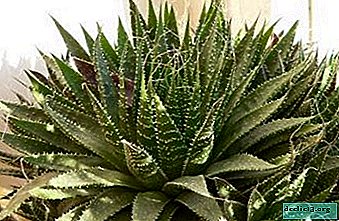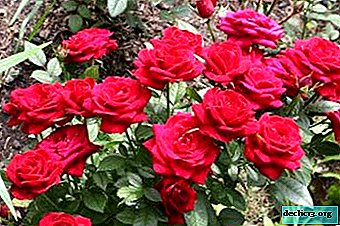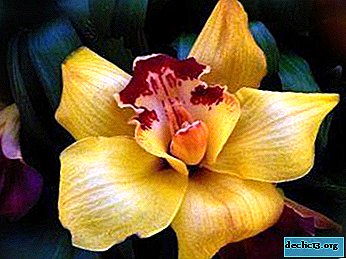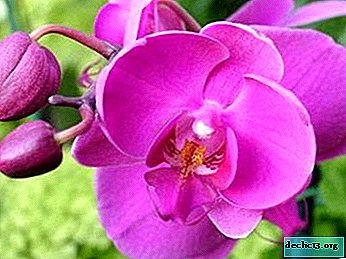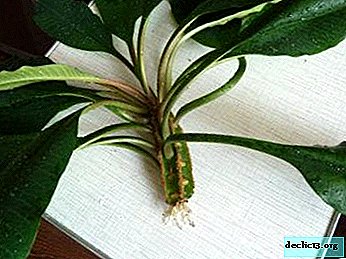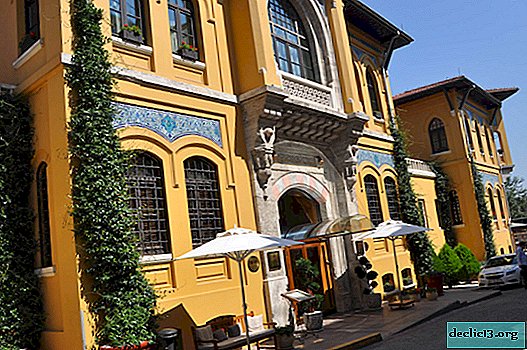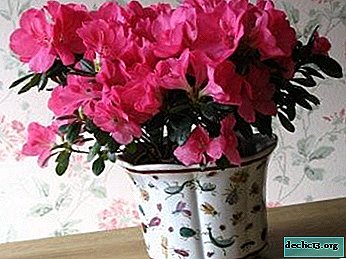Star cactus of extraordinary beauty - houseplant Astrophytum myriostigma
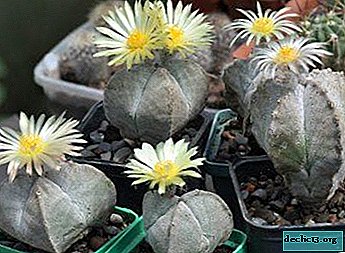
Many animals and plants have the shape of a star in nature: starfish, sea urchins, fruits, fruits. In cactus owls, the shape of a stalk in the shape of a star is generally widespread.
But she received the most perfect incarnation in the myriostigma, a small-sized, but most popular genus, Astrophytum. These are excellent neighbors for “lazy gardeners” due to their unpretentiousness. In addition, a great addition to any interior.
Botanical Description
Astrophytum myriostigma (Latin: Astrophýtum myriostígma) is the most common type of spherical cacti. Translated from Greek, it sounds like "multi-spotted" (stigma - spot).
This houseplant is also known as astrophytum, many-stalked, thousand-speckled, countless speckled, or speckled. For its unusual shape it has the name "bishop's miter".
Reference. The discoverer of Astrophytum myriostigma was Galeotti, who gave the name the name "starfish". Lemer renamed it "plant - star."Appearance
- The size of the plant. Astrophytum myriostigma is a desert spherical cactus. Under natural conditions it reaches a height of 1 m and 20 cm in diameter.
- Stalk of a young shoot represents a small ball, elongating as it grows. Has ashen - green color, without thorns. Covered with specks, which in reality are tufts of villi.
- Ribs It has 5 to 6 thick ribs. There are tubercles on the edges of the ribs.
- Funnel-shaped flowers, appear at the top of the stem. Bright yellow with a reddish edging.
- Fruits and seeds. The diameter of the fruit reaches 2 cm, green color, the seeds when ripe - red - brown, covered with scales with a long pile.
Homeland astrophytum myriostigma is Mexico and the south of the United States, a hot and arid climate.
How to care at home?
Caring for astrophytum myriostigma is not complicated. Indeed, in the natural environment it grows in rather adverse conditions: sultry heat, lack of moisture.
Temperature
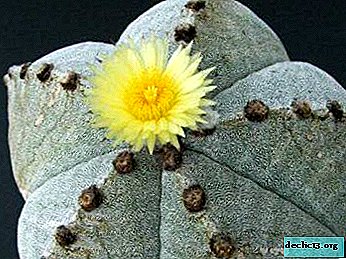 Summer: high temperature is not a problem for the plant. It is wise to place astrophytum in the open air - a balcony, a terrace, protecting it from precipitation.
Summer: high temperature is not a problem for the plant. It is wise to place astrophytum in the open air - a balcony, a terrace, protecting it from precipitation.- In the fall: the flower is preparing for peace. Gradually lower the temperature.
- In winter: a sufficiently low temperature is needed. Up to ten degrees.
- In the spring: gradual increase in temperature to high summer degrees.
Watering
Watering is preferable from the pallet also taking into account the time of year:
- Summer: as the soil dries.
- In spring and fall: once or twice a month.
- In winter: watering for astrophytum is not required.
Overflow contributes to the decay of the roots and base of the stem.
Shine
Astrophytum is photophilous. He does not like the shadow. To shade it is necessary only in the heat.
Priming
The substrate for astrophytum consists of coarse sand, peat, turf and deciduous soil in equal parts. When planting a plant, a drainage layer is laid on the bottom of the pot.
Top dressing
They are produced from mid-spring to mid-autumn once every 3-4 weeks. Special nutrients for cacti are used as nutrients.
Pot
The capacity value is selected depending on the size of the plant. For small specimens, a pot with a diameter of 6-8 cm is usually taken. Given that the root system of the astrophytum does not grow deep, a flowerpot needs a flat one.
Transfer
Important! Transplant during the growth period. A transplant during hibernation can cause decay of the roots damaged during the procedure.A transplant is performed only in urgent need, not more than once every 3 to 5 years. If necessary - more often. Astrophytums do not tolerate transplants.
 The reasons for the transplant may be:
The reasons for the transplant may be:
- An overgrown root system filled the entire container.
- Damage to the root system by rot or pests.
The correct astrophytum transplant is performed in the following order:
- Distribute drainage in a container with a layer of 2.5 - 3 cm.
- Fill a third of the container with a special substrate for cacti.
- Carefully pull the cactus out of the old pot and pay special attention to the root system:
- Carefully clean the roots of the soil.
- Inspect the root neck and roots for rotting and pests.
- Remove rotten roots.
- Carefully spread the roots and place in a flowerpot, gradually filling up the soil between them.
- Add soil to the root neck and place the upper drainage in a small layer.
Do not sprinkle the root neck! This will cause her rot. If the plant lost a lot of roots during transplantation, more river sand should be added to the soil.
Wintering
In winter, the astrophytum has a rest period. To ensure the rest of the plant, the room should be ventilated, dry with a temperature of 5 - 10 degrees.
After the establishment of sunny weather, spraying and fractional watering at room temperature are carried out.
Seed propagation
Propagation by seeds is carried out in early May. Astrophytum seeds are planted in shallow wide tanks.
Step-by-step landing instructions:
- Fill the container with soil mixture. The distance from the surface of the substrate to the edge of the pot should not be less than 2 cm.
- Moisten the soil with a spray bottle.
- Spread seeds on the surface of the soil. Do not sprinkle with earth!
- Put a bag of polyethylene on the pot.
- Create optimal conditions for germination:
- Humidity - 10%.
- Lighting is bright diffused.
- The optimum temperature is 25 - 32 degrees.
- Airing 2 to 3 times a day.
Step-by-step instructions for caring for seedlings:
- After the appearance of the first shoots (usually after 2-3 weeks), provide enhanced lighting. For maximum lighting, fluorescent lamps are recommended.
- Gradually remove the plastic bag. Cover only for the night.
- Watering - from the spray gun.
- Dive when the seedlings begin to interfere with each other in pots 4 - 5 cm in diameter.
Bloom
The astrophytum of myriostigma blooms at the age of 3-4 years. The flowers are silky yellow, large, up to 10 cm in diameter, wide open. Located at the top of the stem. Flowering of one flower lasts only 2 to 4 days. The remaining flowers bloom on each new areola throughout the summer.
Reference: At home, astrophytum blooms very rarely.Plants that are used to surviving in nature under extreme conditions, on the windowsill become moody and demanding. Creating comfortable conditions (ideal temperature, humidity, top dressing) leads to plant growth, its accelerated development, but not flowering.
What to do if it does not bloom?
Proper care of astrophytum implies the creation of conditions of detention that are close to the usual natural habitat of the plant.
- Put astrophytum in direct sunlight. In nature, this type of cactus grows under the scorching rays of the sun.
 Do not turn! Astrophytums do not like changes in the direction of light. In order not to distort the trunk, make a turn once a year, in the fall.
Do not turn! Astrophytums do not like changes in the direction of light. In order not to distort the trunk, make a turn once a year, in the fall.- In winter, do not finish up! In the winter season, generally place them in unlit corners. Such a wintering is favorable for laying buds.
- Establish competent watering. Track the functionality of the drainage holes.
- In winter, put the plant on the balcony! At this time of year, in the habitats of astrophytum, the temperature is quite low. If you do not lower the temperature during the dormant period, then all the energy will go into growth and development, and not to bookmark the buds.
- Optimize feeding. Astrophytum in nature grows on very scarce soils. Excess fertilizer in the pot causes the plant to throw away the baby, not the flower.
Thus, by bringing the conditions of astrophytum closer to the natural ones, it is quite possible to achieve its flowering.
Diseases and Pests
The main pests:
- Scabies and mealybugs. If the damage to the plant is small, wash off the pests with soapy water. Otherwise, treat with an insecticide.
- Rootworms are very difficult to notice. If the astrophytum has stopped growing and withers, and on the roots a white coating is the root mealybug. The plant requires urgent processing.
Similar views
- Astrophytum star - a cactus without thorns. For its resemblance to the marine life, it is called the "sea urchin." The slowest growing species of cactus.
- Capricorn Astrophytum or Capricorn Astrophytum - has long curved thorns in the form of horns.
- The astrophytum is decorated, it is Ornatum - has eight ribs. The areoles of the ribs are decorated with white spines. In nature, it can reach a height of 2 m.
- Astrophytum coaul - densely covered with white felt dots. It blooms with bright yellow large flowers with a purplish - red core.
- Astrophytum jellyfish head - the stalk is short, resembles a cylinder. With tubercles along the entire length. Tubercles can be mistaken for leaves. Their length reaches 19 - 20 cm.
Learn more about the types of astrophytum here.
Astrophytums are a very unusual and interesting group of cacti. Growing them is not easy and troublesome. But worries "pay off" with the rare beauty of this valuable desert flower.

 Summer: high temperature is not a problem for the plant. It is wise to place astrophytum in the open air - a balcony, a terrace, protecting it from precipitation.
Summer: high temperature is not a problem for the plant. It is wise to place astrophytum in the open air - a balcony, a terrace, protecting it from precipitation. Do not turn! Astrophytums do not like changes in the direction of light. In order not to distort the trunk, make a turn once a year, in the fall.
Do not turn! Astrophytums do not like changes in the direction of light. In order not to distort the trunk, make a turn once a year, in the fall.